




What Are Chromosomes?
For a simple answer to the question of ‘what are chromosomes?’, we can say that chromosomes are minute complexes present inside cells which are mainly composed of DNA and proteins. Information present on chromosomes functions as an instructor that instructs cells on how to operate and reproduce. Your chromosomes are the main supply of distinctive characteristics that you will acquire since the day you are born, such as hair colour and height.
Chromosomes are typically invisible to us. Even with a strong microscope, we can't see them because they are so tiny and thin. The chromosomes, on the other hand, wind themselves up and pack tightly when a cell is about to divide. Chromosomes can be seen by scientists using a powerful microscope during the division of cells. They typically exist in pairs.
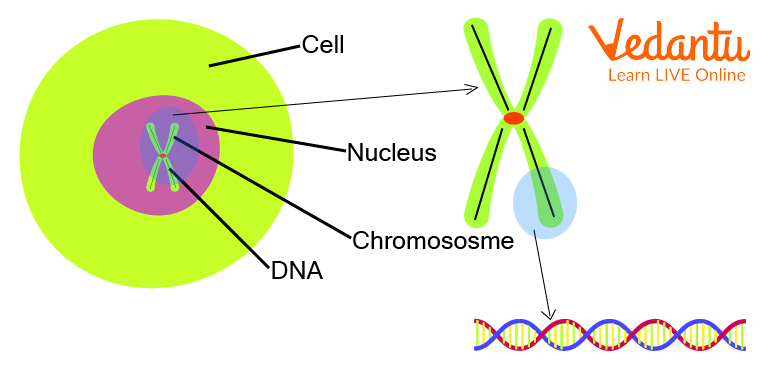
Location and Constituent of Chromosomes
Where Are Chromosomes Found?
If you look at a cell under a microscope, you can see that chromosomes are present inside the nucleus and are usually paired with each. Each cell of varied types of life forms contains a variable set number of chromosomes. For example, normally, each human cell contains 46 chromosomes or 23 pairs of chromosomes. But can vary in the case of polyploidy or disruptive distribution of chromosomes like in the case of down syndrome in which 3 copies of chromosome 21 happen.
How Are Chromosomes Formed?
DNA generally resides in the nucleoplasm, the sticky matrix fluid inside the nucleus, of cells with nuclei as fine fibres. When DNA wraps around a number of tiny proteins known as histones, these strands, which are known as chromatin, start to form. The resultant aggregates, known as nucleosomes, are joined with each other to create an appearance of a string containing beads.
Chromatin is synthesised by winding and compacting the nucleosome threads. Chromatin gets further spiralled into thicker structures called chromosomes as a cell begins to divide for reproduction. And that is how chromosomes are formed. Chromosomes are distributed evenly across the progeny cells after cellular division.
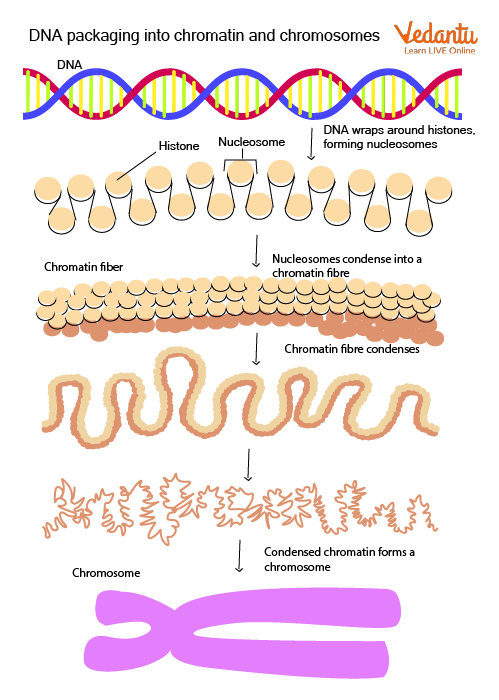
Formation of Chromosome
Describe the Structure of Chromosomes
The structure of a chromosome is called chromatin state or thread-like state when a cell is not dividing (this is referred to as the interphase of the cell cycle). It is an extremely long, thin strand in this form. That strand copies itself and shortens into tube-like structures when the cell begins to divide. The two tubes are compressed together at a location known as the centromere before division. The tubes' "p arms" and "q arms" refer to their shorter and longer respective arms.
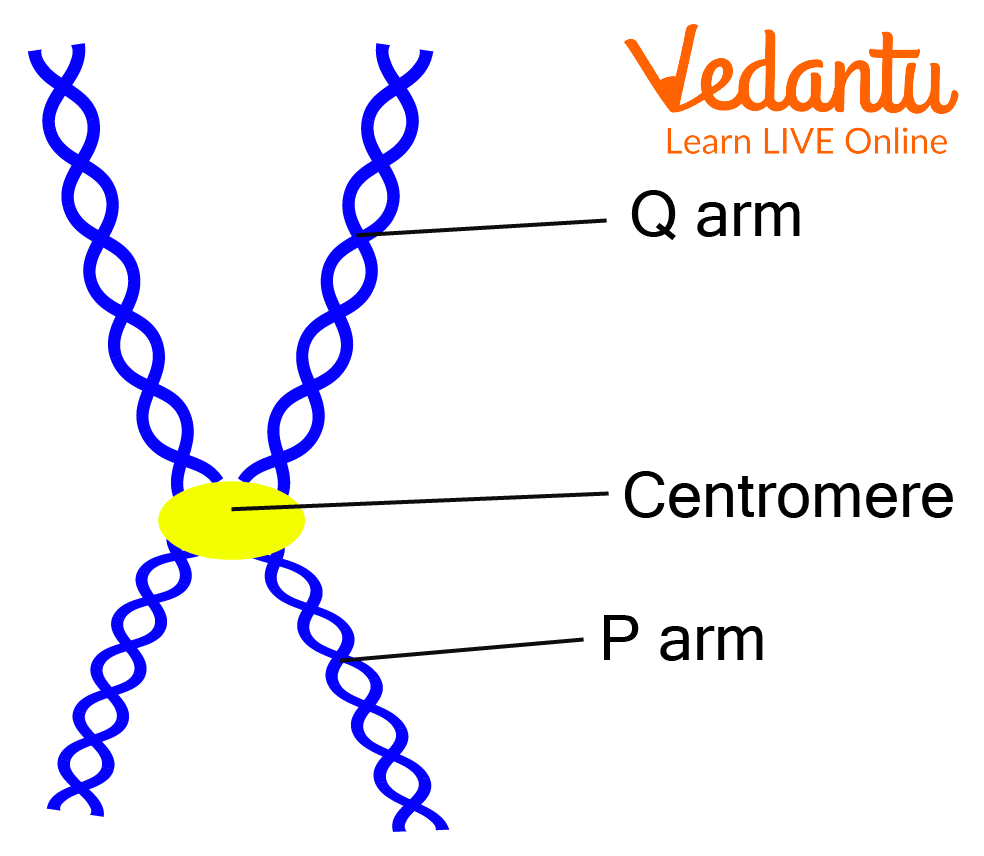
Short and Long Arms of Chromosomes
Types of Chromosomes Based on Position of Centromere
Metacentric- Centromere is present at the centre resulting in equal p and q arms.
Submetacentric- Centromere is present slightly away from the centre resulting in unequal p and q arms.
Acrocentric- Centromere is present slightly below the tip resulting in tiny p arms.
Telocentric- Centromere is present at the end of the tip resulting in no p arms.
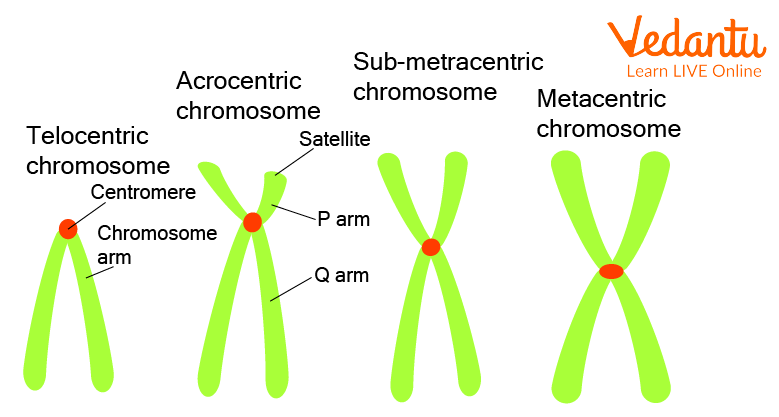
Types of Chromosomes Based on The Position of the Centromere
Human Chromosomes
Humans have 46 chromosomes in all, which are divided into 23 different pairs, as was previously mentioned. Each of our parents gives us 23 chromosomes. These pairings are numbered by scientists from 1 to 22, plus an additional pair is known as the "X/Y" pair. You can tell if you are a man or a woman by your X/Y pair. Males have an X and a Y chromosome, known as the XY, while females have two X chromosomes, known as the XX.
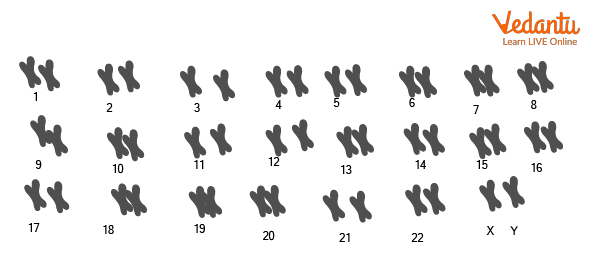
Human Chromosomes
Function of Chromosomes
Below are listed some of the functions of chromosomes.
The main objective of chromosomes is to pass genetic traits from one generation on to the next. Chromosomes further play a vital role during the processes of development like reproduction, repair, and regeneration that are necessary for DNA and chromosomal preservation.
The DNA is guarded by chromosomes from tangling and damage with the help of chromosomes
During cell division, spindle fibres linked to the centromere aid in the movement of the chromosome.
Numerous proteins found in the body are carefully coded by thousands of genes present on each chromosome.
Facts about Chromosomes
The following lists some of the facts about chromosomes.
The number, shape, and size of chromosomes are different in different organisms.
Bacterial cells have an additional set of DNA other than genetic chromosomes.
Some chromosomes have secondary constrictions on them like that of a centromere called a satellite.
Chromosomes of an organism determine whether they are male or female.
Summary
Typically, the bacterial genome does have the shape of a circular chromosome that is found inside the cytoplasm. Instead, in eukaryotes, the genetic material is tightly wrapped in linear chromosomes and conserved in the nucleus. To conclude all the learnings, we can say that chromosomes are responsible for the genetic transfer of traits or characters from the parent generation to the offspring and thereby help in the maintenance of characters over generations. Chromosomes transfer characters from one generation to the other.
FAQs on Facts about Chromosomes to Learn
1. Who was the first person to discover chromosomes?
Walther Flemming made the initial discovery of the chromosome. In 1878, he labelled the nucleus's thread-like structure as chromatin. In 1842, Karl Nageli discovered the rod-shaped chromosomes in plant cells and eventually discovered them to be chromosomes.
2. What is the composition of chromosomes?
DNA, histone proteins, and a centromere, a point of constriction, make up chromosomes. The nucleus is where the chromosomes are constructed. DNA is made up of proteins that are negatively charged and to bind them up together, they need basic proteins like histones that are positively charged. Histones are made up of eight units that help the negatively charged DNA to wind up in it easily and also tightly hold it together till the time of cellular division. Therefore, we can conclude that a chromosome is mainly composed of proteins.
3. What is genetics?
Genetics is the study of how traits and attributes like hair colour, mouth shape, height, and eye colour are passed down from parents to offspring. It studies the DNA, genes, chromosomes, their division, and segregation.









